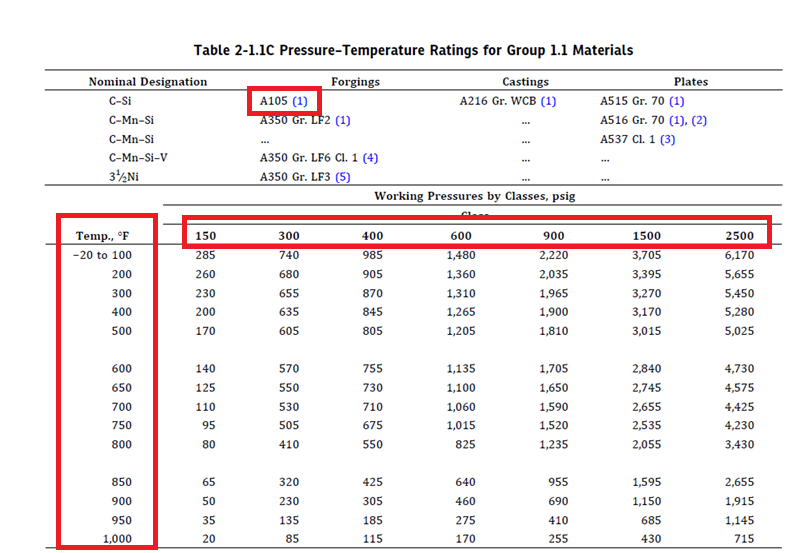ASME B16.5: Pipe Flanges and Flanged Fittings

ASME B16.5: Pipe Flanges and Flanged Fittings
What is the purpose of ASME B16.5 Pipe Flanges and Flanged Fittings?
ASME B16.5 specifies
- Dimensions
- Materials
- Pressure-temperature ratings
- Tolerances
- Marking
- Testing for pipe flanges and flanged fittings.
Where ASME B16.5 applicable (Materials And Units)?
- It applies to flanges with nominal pipe sizes (NPS) ranging from ½ inch to 24 inches
- Fittings made from materials such as steel, nickel alloys, and other ferrous materials.
- ASME B16.5 is limited to
- Flanges and flanged fittings made from cast or forged materials
- Blind flanges and certain reducing flanges made from cast, forged, or plate materials
Flanges and Flanged fittings units
- Both metric and U.S. Customary units
- Flanges with rating class designations 150, 300, 400, 600, 900, and 1500 in sizes NPS 1∕2 through NPS 24
- Flanges with rating class designation 2500 in sizes NPS 1∕2 through NPS 12
- Flanged fittings with rating class designation 150 and 300 in sizes NPS 1∕2 through NPS 24
- U.S. Customary units
- Flanged fittings with rating class designation 400, 600, 900, and 1500 in sizes NPS 1∕2 through NPS 24
- Flanged fittings with rating class designation 2500 in sizes 1 ∕ 2 through NPS 1 2.
US Customary units include units for measuring length, weight, capacity, and temperature. For instance Length: Measured in inches, feet, yards, and miles; Weight: Measured in ounces, pounds, and tons;
- The selection of materials suitable for particular fluid services are not within the scope of this Standard.
Pressure-temperature ratings
Pressure–temperature ratings are maximum allowable working guage pressures in bar units at the temperatures in degrees Celsius. Besides pressure in psig and Temperature in degree F heat also provided
- Ratings of Flanged Joints
- If two flanges in a joint have different pressure-temperature ratings, the joint’s rating will be the lower of the two at any given temperature.
- A flanged joint is composed of separate and independent components: the flanges, gasket, and bolting, all these elements to
attain a joint that has acceptable leak tightness.
Impact of Temperature on Flange
- At High Temperature
- When temperatures cause flanges, bolts, and gaskets to relax, bolt loads decrease.
- This can lead to leakage in flanged joints, especially if subjected to thermal gradients.
- At temperatures above 200°C for Class 150 and 400°C for other classes, care is needed to prevent severe external loads and thermal gradients to avoid leakage.
- At Low Temperature
- Some materials, especially certain carbon steels, may lose ductility at low temperatures and become unable to resist shock, stress changes, or high-stress concentration.
- Some regulations may require impact testing even at temperatures above −29°C.
- It is the user’s responsibility to inform the manufacturer of these requirements before making a purchase.
Testing
- Flanged joints and fittings can be tested at 1.5 times the 38°C (100°F) pressure rating, rounded up to the next 1 bar (25 psi).
- Any higher pressure testing is the user’s responsibility, following relevant codes or regulations.
Identification Markings
- Manufacturer’s name
- Material used to be mentioned
- Rating Designation i.e., 150, 300, 400, 600, 900, 1500, or 2500
- Mention designation B16 or B16.5.
- Temperature markings are not required on flanges or flanged fittings
- NPS designation shall be marked on flanges and flanged fittings
- The edge (periphery) of each ring joint flange shall be marked with the letter R
Pressure-Temperature Ratings
Step 1. First Select the Table from below the List of Materials provided in ASME B16.5. Here we consider A105.

Step 2. Refer to the table. 2-1.1 taken from the list and identified the rating as shown below.

Example
- Consider pressure 19.2 and Temperature 48°C. The rating will be 150#.
